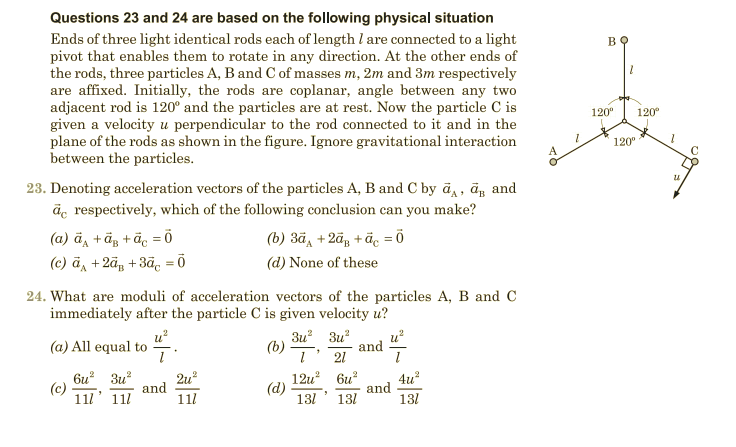Ends of three light identical rods each of length I are connected to a light pivot that enables them to rotate in any direction. At the other ends of the rods, three particles A, B and C of masses m, 2m and 3m respectively are affixed. Initially, the rods are coplanar, angle between any two adjacent rod is 120° and the particles are at rest. Now the particle C is given a velocity u perpendicular to the rod connected to it and in the plane of the rods as shown in the figure. Ignore gravitational interaction between the particles. . Denoting acceleration vectors of the particles A, B and C by ā , ä, and äc respectively, which of the following conclusion can you make?
Ends of three light identical rods each of length I are connected to a light pivot that enables them to rotate in any direction. At the other ends of the rods, three particles A, B and C of masses m, 2m and 3m respectively are affixed. Initially, the rods are coplanar, angle between any two adjacent rod is 120° and the particles are at rest. Now the particle C is given a velocity u perpendicular to the rod connected to it and in the plane of the rods as shown in the figure. Ignore gravitational interaction between the particles. . Denoting acceleration vectors of the particles A, B and C by ā , ä, and äc respectively, which of the following conclusion can you make?
Related questions
Question
Pls Find the Question attached

Transcribed Image Text:Questions 23 and 24 are based on the following physical situation
Ends of three light identical rods each of length l are connected to a light
pivot that enables them to rotate in any direction. At the other ends of
the rods, three particles A, B and C of masses m, 2m and 3m respectively
are affixed. Initially, the rods are coplanar, angle between any two
adjacent rod is 120° and the particles are at rest. Now the particle C is
given a velocity u perpendicular to the rod connected to it and in the
plane of the rods as shown in the figure. Ignore gravitational interaction
between the particles.
BO
120°
120°
120"
23. Denoting acceleration vectors of the particles A, B and C by ā,, ā, and
äc respectively, which of the following conclusion can you make?
= ö
(b) Зад + 2ӑ, + ӑ, - б
(d) None of these
(a) ä, +äg +āc
%3D
(c) ä, +2ã, +3ã, = ö
24. What are moduli of acceleration vectors of the particles A, B and C
immediately after the particle C is given velocity u?
u?
(a) All equal to ".
3u 3u?
and
21
u?
(b)
6u? 3u?
(c)
111' 111
2u?
and
111
12u 6u?
and
131
4u?
(d)
131
131
Expert Solution
This question has been solved!
Explore an expertly crafted, step-by-step solution for a thorough understanding of key concepts.
Step by step
Solved in 2 steps with 2 images
